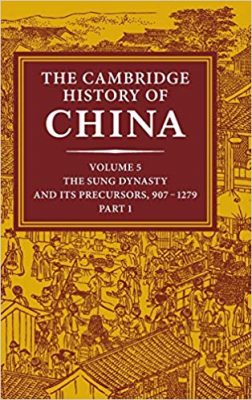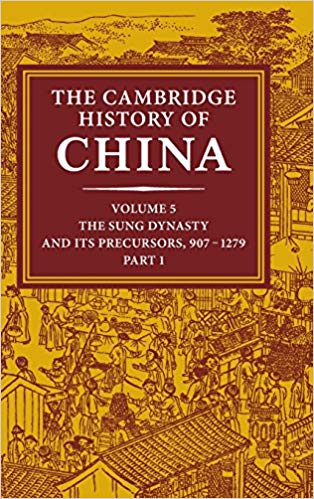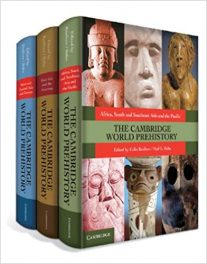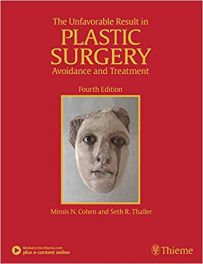 General Editors: Denis Twitchett and John K. Fairbank
General Editors: Denis Twitchett and John K. Fairbank
Editors: Denis Twitchett and Paul Jakov Smith
Publisher: Cambridge University Press – 1,095 pages
Book Review by: Sonu Chandiram
This Volume 5 of the Cambridge History of China, almost 1,100 pages in length, covers a period of 372 years, from the year 907 to the year 1279.
Most of the reigns of the emperors during this time were very short in length, such as those of Ying-tsung (just four years), Hui-tsung and Ch’in-tsung (just about one year each) and Kuang-tsung (five years). Other emperors ruled for much longer periods, such as Jen-tsung and Li-tsung (about 40 years each) and Ning-tsung (30 years). Why such big gaps is a question on which I could not find an answer easily.
The 12 chapters of this book have been authored and coauthored by different scholars including the editors, but all their names are not found in a single list as is typically the situation in other books. This lengthy and thick book contains a dozen chapters, and we list their titles below to
provide you a broad overview of its contents:
Introduction
- The Five Dynasties
- The Southern Kingdoms Between the Tang and the Sung, 907-979
- Founding and Consolidation of the Sung Dynasty Under T’ai-tsu
- The Reigns of Jen-tsung (1022-1063) and Ying-tsung (1063-1067)
- Shen-tsung’s Reign and the New Policies of Wan An-shih (1067-1085)
- Che-tsung’s Reign (1085-1100)and the Age of Faction
- The Reigns of Hui-tsung (1100-1126) and Ch’in-tsung (1126-1127) and the Fall of the Northern Sung
- The Move to the South and the Reign of Kao-tsung (1127-1162)
- The Reign of Hsiao-tsung (1162-1189)
- The Reigns of Kuang-tsung (1189-1194) and Ning-tsung (1194-1224)
- The Reign of Li-tsung (1224-1264)
- The Reign of Tu-tsung (1264-1274) and His Successors to 1279
Information on the history of China in the years within the fourth to the thirteenth centuries is provided to you in this book in other forms besides text. Figures, maps, and tables are several additional means that illustrate what was going on in China during those years.
The maps show a much smaller China during that 372-year period than what we are familiar with at the present. The figures show you the family members of the rulers, among other data. The tables show you the rulers’ policies, the populations of people living in certain areas of China.
One of these tables, entitled Percentage of People in Active Pao-Chia Service, 1076, shows varied percentages of people among some 15 million people in 19 areas of the country who were engaged in pao-chia service and drill service in the year 1076.
The percentages varied from as few as 25.7 percent of people in Ho-pei (East and West) engaged in pao-chia service and 20.4 percent in drill service, to as many as 31.3 percent and 30 percent respectively in pao-chia and drill service from the Capital Region.
The Table also shows that the maximum percentage of people engaged in pao-chia service was 71.7 percent from the Ching-hsi area, numbering 467,535 of the 651,742 people in that area.
Looking back into the histories of people centuries ago, particularly human behavior, shows many similarities to human behavior in our world today, in particular what motivates people to take certain actions. Money is one of those primary motivations.
So it is interesting to look at the origin of pao-chia and drill services. These are essentially two types of rural credit that farmers then earned to offset the cost of interest charges they paid on ‘green sprouts loans’.
On pages 414 and 415 in chapter 5 entitled Shien-Tsung’s Reign and the New Policies 0f Wang An Shih, 1067-1085, the chapter author Paul Jakov Smith writes on the topic of rural credit under the heading From Economic Redistribution to Revenue Extraction:
“In a policy-making environment dominated by the quest for funds to finance new state initiatives and the emperor’s northern campaigns, the redistribution rationale that justified the new economic policies was soon sacrificed to the need for revenues.
“The green sprouts policy was the first measure to succumb to the hunger for revenues, despite the governments express disavowal of a fiscal interest in the loan fund. In the eyes of critics of the policy, fiscalization was signaled by the imposition of interest charges on the green sprouts loans. No provisions were made for interest charges in the original directive of the ninth month of 1069, but within a few months rates of twenty to thirty percent annually were imposed in order to finance the plan.
“Critics such as Han Ch’i, Ou-yang Hsui, and Sau-ma Kang denounced the unseemliness of government usury, and predicted that the collection of interest fee3s would soon supersede rural credit relief as the primary operations goal of the farming loan policy. Wang countered that although charging interest on the government loans was by no means ideal, the practice, which was sanctioned by the canonical Chou-li, was the only way to keep the loan fund solvent.”
This is a good book on one small segment – less than four centuries – of China’s long history of many millennia. It is supported by excellent and detailed research including people, places, word meanings, and much more. It is an outstanding contribution to our understanding of China and its people, and what were some of its major historical waves of events.







